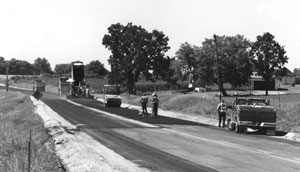U.S. Department of Transportation
Federal Highway Administration
1200 New Jersey Avenue, SE
Washington, DC 20590
202-366-4000
Focus
| Accelerating Infrastructure Innovations |
Publication Number: FHWA-RD-02-009
Date: April 2002
Did you drive on a recycled pavement today? Reclaimed asphalt pavement (RAP), the term used to describe reprocessed pavement materials containing asphalt and aggregates, is now routinely used in nearly all 50 States. The Federal Highway Administration (FHWA) estimates that nearly 30 million tons of RAP are recycled into hot-mix asphalt (HMA) pavements each year, saving taxpayers more than $300 million annually by reducing material and disposal costs. But can RAP be incorporated into pavements built using the Superpave mix design system? As originally developed by the Strategic Highway Research Program, the Superpave system did not contain guidelines for the inclusion of RAP. However, State experiences to date have indicated that RAP can be used in Superpave mixes both predictably and reliably, as long as the unique properties of the RAP are known. The recently completed National Cooperative Highway Research Program (NCHRP) project 9-12, led by Rebecca McDaniel of the North Central Superpave Center and Mike Anderson of the Asphalt Institute, confirms that the Superpave system can easily and effectively accommodate the use of RAP.
"While some States had been using RAP in Superpave, many were waiting for guidelines to come out. This is really going to open it up in terms of use," says McDaniel.
The primary objective of NCHRP Project 9-12, "Incorporation of Reclaimed Asphalt Pavement in the Superpave System," was to answer several key questions:
After conducting a comprehensive laboratory testing program using RAP materials from field projects in Arizona, Connecticut, and Florida, the researchers concluded that partial binder blending occurs to a significant extent when using RAP. Low amounts of RAP, typically up to 15 percent, can be used without performing any binder tests or making changes to the binder grade. For intermediate amounts of RAP in the 15- to 25-percent range, the recommended virgin asphalt binder is one grade "softer" than that used for conventional HMA. In mixes containing more than 25 percent RAP, the RAP binder will have a noticeable effect and must also be accounted for by using a softer grade of virgin asphalt binder.
To determine the correct grade of virgin asphalt binder for mixes containing more than 25-percent RAP, the RAP binder must be extracted, recovered, and tested to develop blending charts. The desired final binder grade and critical temperatures of the RAP binder are needed to construct a blending chart. Once the physical properties and critical temperatures of the RAP binder are known, a materials engineer can take one of two approaches: (1) The percentage of RAP is specified and the blending chart is used to determine the appropriate virgin binder grade; or (2) The virgin binder grade is specified and the blending chart is used to determine the maximum percentage of RAP that may be used. Step-by-step procedures for constructing blending charts can be found in NCHRP Report 452, Recommended Use of Reclaimed Asphalt Pavement in the Superpave Mix Design Method: Technician's Manual, which is available on the Web at http://pubsindex.trb.org/document/view/default.asp?lbid=677089.
The researchers also determined that only minor changes need to be made to the overall Superpave mix design process when using RAP. Although RAP can be treated like any other aggregate stockpile for blending and weighing, it must be heated gently to avoid changing the RAP binder properties. Also, the RAP aggregate specific gravity must be estimated. The weight of the binder in the RAP must be accounted for when batching aggregates and the total asphalt content reduced to compensate for the RAP binder.
Other factors to consider when using RAP are those related to production and quality control testing. Higher plant temperatures are necessary if the ambient temperature is low or the moisture content of the materials is high. Stricter material stockpile management and more frequent sampling and testing of the RAP may also be necessary to ensure consistency and quality.
For more information on the NCHRP project or on using RAP in Superpave mixes, contact Rebecca McDaniel at the North Central Superpave Center, 765-463-2317, x. 226 (email: rsmcdani@purdue.edu). The project report, Recommended Use of Reclaimed Asphalt Pavement in the Superpave Mix Design Method.
 |
| Research has confirmed that Superpave pavements can easily accommodate the use of RAP. |